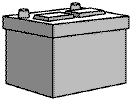Lead Battery Facts

Aside from exhaust pipe emissions, lead batteries have the most detrimental environmental impact of any part of an automobile. Every car battery contains approximately 18-20 pounds of lead.1 Lead batteries are also widely used for forklifts, golf carts, and for backup power in the computer, solar, and telecommunication industries.
Inefficient manufacturing and recycling operations release tons of lead into the environment. During battery manufacturing and recycling operations, lead is melted and resulting fumes are released into the air causing significant occupational exposures. This toxic metal is also released into the larger environment where it is a source of airborne exposure, before settling to contaminate dust and soil.
Lead contamination persists in dust and soil and is often the most significant route of exposure to young children who generally play close to the ground and have regular hand-to-mouth contact. In addition, environmental contamination of ground and surface water may also occur. Lead from these sources is bioaccumulative and has significant adverse impacts on all species. This natural resource is being widely used in this unsustainable manner with implications for the health of natural ecosystems and humans. Consider the following facts:
- About 90% of global lead production goes into making lead batteries.
- Approximately 800 million children are over exposed to lead above 5 µg/dl and the most severely affected are in the low and middle-income countries.2
- Global lead battery production is estimated to be worth $42 billion in 2023 and is steadily growing.3
- Approximately 92% of all lead used in the U.S. in 2010 went into batteries and approximately 86% of all global lead consumption goes into batteries.4 5
Isn't it true that over 90 percent of all batteries are recycled?
- Although recycling rates for lead batteries are very high in most countries, the process can cause a significant amount of lead to be emitted into the environment unless it is done in proper facilities. In the developing world, used lead batteries are routinely melted down for scrap in backyards and on the side of roads. Almost all formal “licensed” facilities in most low and middle-income countries for recycling that are highly polluting.
Are lead emission and exposure standards in the U.S. adequate?
- The U.S. Environmental Protection Agency (EPA) revised the National Air Quality standard for lead in 2008 with a 10-fold decrease from 1.5 μg/m³ to 0.15 μg/m6. California recently lowered the occupational Permissible Exposure Limit (PEL) for lead in air in the workplace to 10 µg/m3.6 However, the federal U.S. OSHA standard for airborne lead in the workplace have not changed since the 1970s despite a clear understanding of the harmful health effects of lead at permissible exposure levels. Workers are routinely exposed to harmful levels of lead under existing regulatory levels in lead battery facilities in the U.S. and most other countries.
Are more lead batteries produced in developing countries to avoid U.S. pollution control laws?
- Imports of new lead batteries to the U.S. are increasing as primary production and recycling shifts to developing countries with fewer environmental regulations and less enforcement capacity. Many imported lead batteries enter the U.S. in new cars, which account for almost half of all new car sales, but even more are imported for the replacement market.7
Are more batteries being recycled in developing countries to avoid U.S. pollution control laws?
- Mexico is the largest importer of used lead batteries from the U.S. and this has been increasing since the U.S. lowered the ambient air quality standard for lead in 2008. Exports of used lead batteries from the U.S. to Mexico increased 23% from 2017 to 2021.
Are there substitutes for lead batteries?
- Although there are substitutes for lead batteries, they contain other heavy metals such as nickel, cobalt, manganese, and lithium which cannot be recycled without significant subsidies, but lithium-ion batteries significantly outlast lead batteries. These alternatives cost considerably more than lead batteries and also pose significant environmental and health impacts if not carefully manufactured and disposed of properly.
Do hybrid and electric cars contain lead batteries?
- Almost every electric and hybrid vehicle uses a lithium-ion battery along with a conventional lead battery.
Notes:
1 https://www.des.nh.gov/sites/g/files/ehbemt341/files/documents/mvsy-bmp12-batteries.pdf
2 https://www.niehs.nih.gov/health/topics/agents/lead
3 https://www.globenewswire.com/news-release/2024/02/20/2831632/0/en/Global-Lead-Acid-Battery-Market-Size-To-Worth-USD-68-3-Billion-By-2033-CAGR-of-4-9.html
4 U.S. Geological Survey, Mineral Commodity Summaries 2023, https://pubs.usgs.gov/periodicals/mcs2023/mcs2023-lead.pdf
5 UNEP https://www.unep.org/topics/chemicals-and-pollution-action/pollution-and-health/heavy-metals/used-lead-acid-batteries
6 https://www.aiha.org/news/240229-cal-osha-standards-board-approves-revisions-to-state-lead-standards
7 https://www.cargroup.org/wp-content/uploads/2019/02/US-Consumer-Economic-Impacts-of-US-Automotive-Trade-Policies-.pdf
